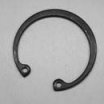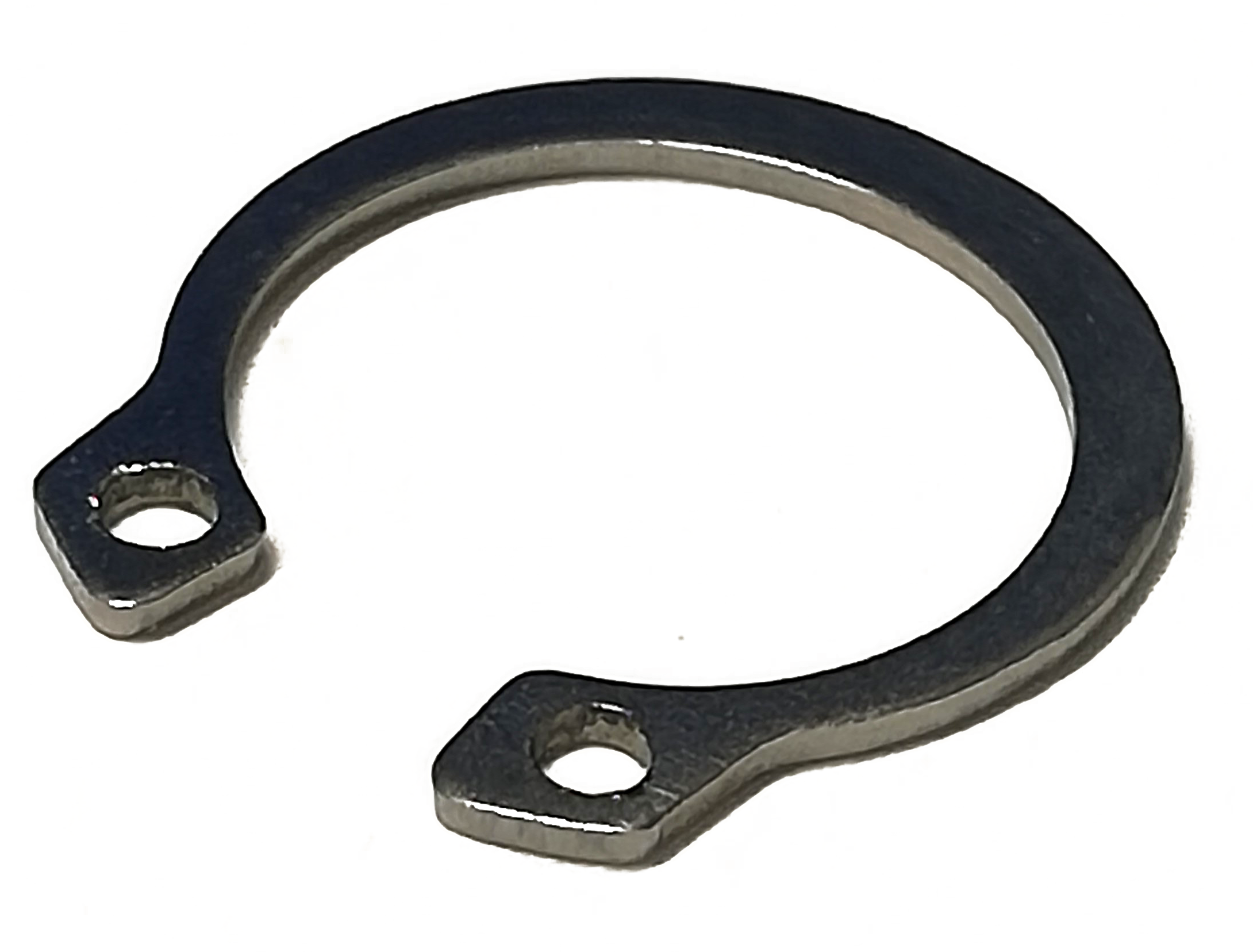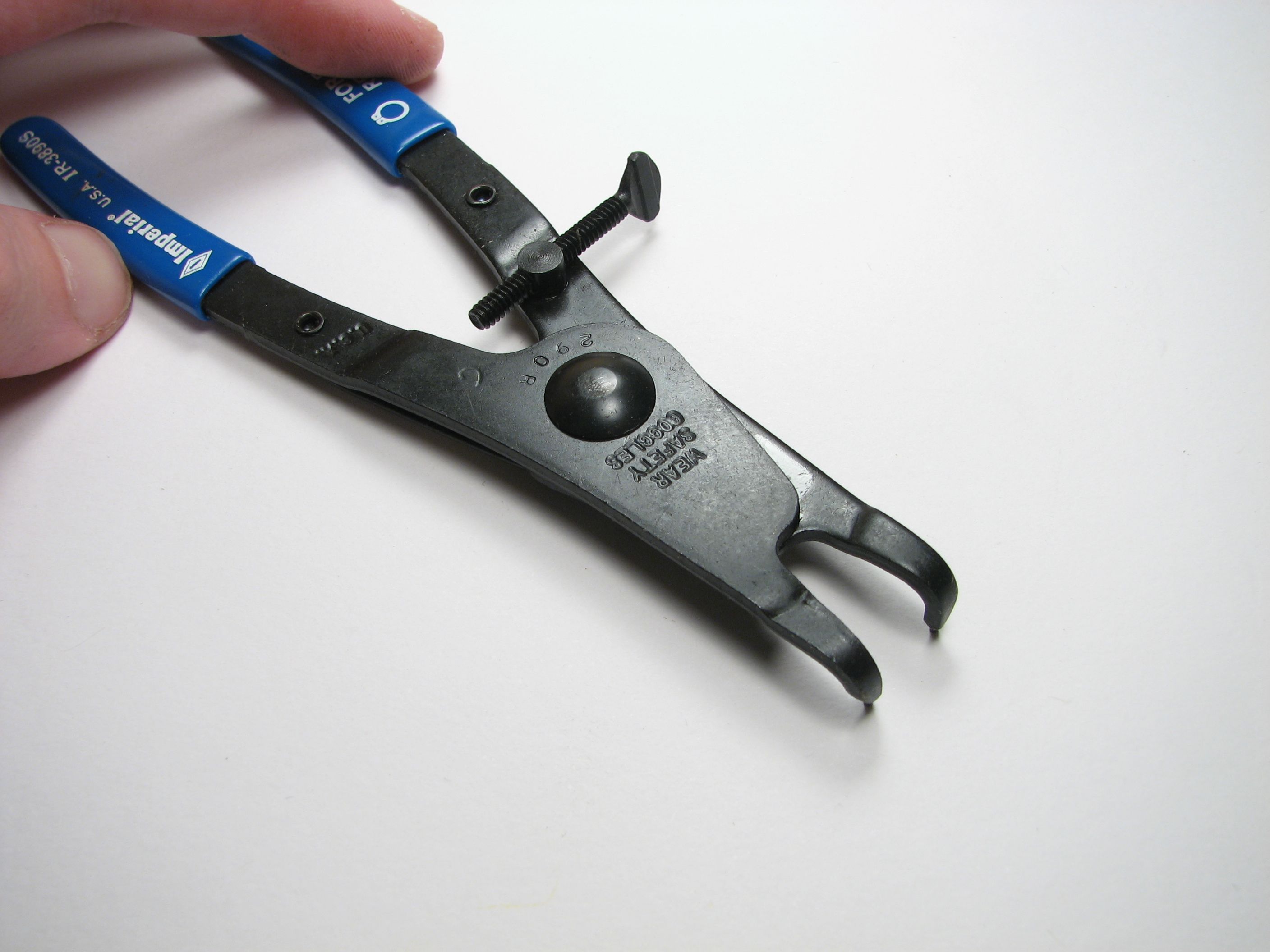|
Circlip
A circlip (a portmanteau of "circle" and "clip"), also known as a C-clip, Rotor Clip, snap ring or Jesus clip, is a type of fastener or retaining ring consisting of a semi-flexible metal ring with open ends which can be snapped into place, into a machined groove on a dowel pin or other part to permit rotation but to prevent axial movement. There are two basic types: internal and external, referring to whether they are fitted into a bore or over a shaft. Circlips are often used to secure pinned connections. Details When used to retain piston wrist pins or gudgeon pins, the clips are known as wrist pin clips, wrist pin retainers, or gudgeon pin clips. The most commonly used circlip for this application is a simple spring steel circlip, or plain wire ring. The term "Jesus clip" comes from the propensity of the clip's spring action to launch the clip at a high velocity when removing or installing, leading to remarks such as, "Oh Jesus, where did it go?" E-clip Common exam ... [...More Info...] [...Related Items...] OR: [Wikipedia] [Google] [Baidu] |
Circlip
A circlip (a portmanteau of "circle" and "clip"), also known as a C-clip, Rotor Clip, snap ring or Jesus clip, is a type of fastener or retaining ring consisting of a semi-flexible metal ring with open ends which can be snapped into place, into a machined groove on a dowel pin or other part to permit rotation but to prevent axial movement. There are two basic types: internal and external, referring to whether they are fitted into a bore or over a shaft. Circlips are often used to secure pinned connections. Details When used to retain piston wrist pins or gudgeon pins, the clips are known as wrist pin clips, wrist pin retainers, or gudgeon pin clips. The most commonly used circlip for this application is a simple spring steel circlip, or plain wire ring. The term "Jesus clip" comes from the propensity of the clip's spring action to launch the clip at a high velocity when removing or installing, leading to remarks such as, "Oh Jesus, where did it go?" E-clip Common exam ... [...More Info...] [...Related Items...] OR: [Wikipedia] [Google] [Baidu] |
Snapring Or Circlip Extraction From Bicycle Hub
A circlip (a portmanteau of "circle" and "clip"), also known as a C-clip, Rotor Clip, snap ring or Jesus clip, is a type of fastener or retaining ring consisting of a semi-flexible metal ring with open ends which can be snapped into place, into a machined groove on a dowel pin or other part to permit rotation but to prevent axial movement. There are two basic types: internal and external, referring to whether they are fitted into a bore or over a shaft. Circlips are often used to secure pinned connections. Details When used to retain piston wrist pins or gudgeon pins, the clips are known as wrist pin clips, wrist pin retainers, or gudgeon pin clips. The most commonly used circlip for this application is a simple spring steel circlip, or plain wire ring. The term "Jesus clip" comes from the propensity of the clip's spring action to launch the clip at a high velocity when removing or installing, leading to remarks such as, "Oh Jesus, where did it go?" E-clip Common exam ... [...More Info...] [...Related Items...] OR: [Wikipedia] [Google] [Baidu] |
Fastener
A fastener (US English) or fastening (UK English) is a hardware device that mechanically joins or affixes two or more objects together. In general, fasteners are used to create non-permanent joints; that is, joints that can be removed or dismantled without damaging the joining components. Welding is an example of creating permanent joints. Steel fasteners are usually made of stainless steel, carbon steel, or alloy steel. Other alternative methods of joining materials include: crimping, welding, soldering, brazing, taping, gluing, cement, or the use of other adhesives. Force may also be used, such as with magnets, vacuum (like suction cups), or even friction (like sticky pads). Some types of woodworking joints make use of separate internal reinforcements, such as dowels or biscuits, which in a sense can be considered fasteners within the scope of the joint system, although on their own they are not general purpose fasteners. Furniture supplied in flat-pack form oft ... [...More Info...] [...Related Items...] OR: [Wikipedia] [Google] [Baidu] |
Groove (machining)
In manufacturing or mechanical engineering a groove is a long and narrow indentation built into a material, generally for the purpose of allowing another material or part to move within the groove and be guided by it. Examples include: # A canal cut in a hard material, usually metal. This canal can be round, oval or an arc in order to receive another component such as a boss, a tongue or a gasket. It can also be on the circumference of a dowel, a bolt, an axle or on the outside or inside of a tube or pipe etc. This canal may receive a circlip, an o-ring, or a gasket. # A depression on the entire circumference of a cast or machined wheel, a pulley or sheave. This depression may receive a cable, a rope or a belt. # A longitudinal channel formed in a hot rolled rail profile such as a grooved rail. This groove is for the flange on a train wheel. Grooves were used by ancient Roman engineers to survey land. See also * Fluting (architecture) * Gland (engineering) * Glass ... [...More Info...] [...Related Items...] OR: [Wikipedia] [Google] [Baidu] |
Needle-nose Pliers
Needle-nose pliers, also known as long-nose pliers and snipe-nose pliers, are both cutting and holding pliers used by artisans, jewellery designers, electricians, network engineers and other tradesmen to bend, re-position and snip wire. Their namesake long nose gives excellent control while the cutting edge near the pliers' joint provides "one-tool" convenience. Because of their long shape they are useful for reaching into small areas where cables or other materials have become stuck or unreachable with fingers or other means. Bent nose pliers, also named bent needle-nose pliers, curved nose pliers or curved needle-nose pliers, have a curved beak. Bent needle-nose pliers, 326x326px Wiring pliers, are used to cut, strip and manipulate wire during the process of terminating it. See also *Lineman's pliers Lineman's pliers (US English), Kleins (genericized trademark, US usage), linesman pliers (Canadian English), side cutting linesman pliers and combination pliers (UK / US Engli ... [...More Info...] [...Related Items...] OR: [Wikipedia] [Google] [Baidu] |
Routledge
Routledge () is a British multinational publisher. It was founded in 1836 by George Routledge, and specialises in providing academic books, journals and online resources in the fields of the humanities, behavioural science, education, law, and social science. The company publishes approximately 1,800 journals and 5,000 new books each year and their backlist encompasses over 70,000 titles. Routledge is claimed to be the largest global academic publisher within humanities and social sciences. In 1998, Routledge became a subdivision and imprint of its former rival, Taylor & Francis Group (T&F), as a result of a £90-million acquisition deal from Cinven, a venture capital group which had purchased it two years previously for £25 million. Following the merger of Informa and T&F in 2004, Routledge became a publishing unit and major imprint within the Informa "academic publishing" division. Routledge is headquartered in the main T&F office in Milton Park, Abingdon, Oxfords ... [...More Info...] [...Related Items...] OR: [Wikipedia] [Google] [Baidu] |
Motion (physics)
In physics, motion is the phenomenon in which an object changes its position with respect to time. Motion is mathematically described in terms of displacement, distance, velocity, acceleration, speed and frame of reference to an observer and measuring the change in position of the body relative to that frame with change in time. The branch of physics describing the motion of objects without reference to its cause is called kinematics, while the branch studying forces and their effect on motion is called dynamics. If an object is not changing relative to a given frame of reference, the object is said to be ''at rest'', ''motionless'', ''immobile'', '' stationary'', or to have a constant or time-invariant position with reference to its surroundings. Modern physics holds that, as there is no absolute frame of reference, Newton's concept of '' absolute motion'' cannot be determined. As such, everything in the universe can be considered to be in motion. Motion applies to various ... [...More Info...] [...Related Items...] OR: [Wikipedia] [Google] [Baidu] |
Rotation
Rotation, or spin, is the circular movement of an object around a '' central axis''. A two-dimensional rotating object has only one possible central axis and can rotate in either a clockwise or counterclockwise direction. A three-dimensional object has an infinite number of possible central axes and rotational directions. If the rotation axis passes internally through the body's own center of mass, then the body is said to be ''autorotating'' or '' spinning'', and the surface intersection of the axis can be called a '' pole''. A rotation around a completely external axis, e.g. the planet Earth around the Sun, is called ''revolving'' or ''orbiting'', typically when it is produced by gravity, and the ends of the rotation axis can be called the '' orbital poles''. Mathematics Mathematically, a rotation is a rigid body movement which, unlike a translation, keeps a point fixed. This definition applies to rotations within both two and three dimensions (in a plane and in spa ... [...More Info...] [...Related Items...] OR: [Wikipedia] [Google] [Baidu] |
Dowel
A dowel is a cylindrical rod, usually made of wood, plastic, or metal. In its original manufactured form, a dowel is called a ''dowel rod''. Dowel rods are often cut into short lengths called dowel pins. Dowels are commonly used as structural reinforcements in cabinet making and in numerous other applications, including: * Furniture shelf supports * Moveable game pieces (i.e. pegs) * Hangers for items such as clothing, key rings, and tools * Wheel axles in toys * Detents in gymnastics grips * Supports for tiered wedding cakes Wood dowel Manufacturing process The traditional tool for making dowels is a ''dowel plate'', an iron (or better, hardened tool steel) plate with a hole having the size of the desired dowel. To make a dowel, a piece of wood is split or whittled to a size slightly bigger than desired and then driven through the hole in the dowel plate. The sharp edges of the hole shear off the excess wood.Ivin SickelsExercises in Wood-Working American Book Compa ... [...More Info...] [...Related Items...] OR: [Wikipedia] [Google] [Baidu] |
Retaining Ring
A retaining ring is a fastener that holds components or assemblies onto a shaft or in a housing/bore when installed - typically in a groove - for one time use only. Once installed, the exposed portion acts as a shoulder which retains the specific component or assembly. Circlips are a type of retaining ring. Circular push-on retaining rings may be installed in applications where there is no groove. Retaining rings are typically made from carbon steel, stainless steel or beryllium copper and may feature a variety of finishes for aesthetics and corrosion protection depending on the type of environment in which they are used. Types There are four main types of retaining rings available, each of which may then be broken down into sub-types depending on unique application needs: *Tapered section **Axially assembled ***Inverted *** Beveled ***Bowed **Radially assembled **Self-locking *Constant section *Spiral *Circular push-on Tapered section retaining rings Tapered section ... [...More Info...] [...Related Items...] OR: [Wikipedia] [Google] [Baidu] |
Machining
Machining is a process in which a material (often metal) is cut to a desired final shape and size by a controlled material-removal process. The processes that have this common theme are collectively called subtractive manufacturing, which utilizes machine tools, in contrast to '' additive manufacturing'' (3D printing), which uses controlled addition of material. Machining is a part of the manufacture of many metal products, but it can also be used on other materials such as wood, plastic, ceramic, and composite material. A person who specializes in machining is called a machinist. A room, building, or company where machining is done is called a machine shop. Much of modern-day machining is carried out by computer numerical control (CNC), in which computers are used to control the movement and operation of the mills, lathes, and other cutting machines. This increases efficiency, as the CNC machine runs unmanned therefore reducing labour costs for machine shops. History and ter ... [...More Info...] [...Related Items...] OR: [Wikipedia] [Google] [Baidu] |







